|
The No No Drill The First Steps In Teaching Cupcake To Handle by Frank Holbert The No No drill is the first handling drill Adrienne and I teach a dog. We teach this before the Tee pattern and long before a dog learns to sit on a whistle. Adrienne and I learned this drill from Bill Kolstad, I've never seen it in any books. Bill taught this drill to our training group in 1992 and we have used it since. The handler will be saying NO SIT! NO SIT! throughout the first few days, hence the name ‘No No Drill’. This drill is done best in short grass. Never run this drill in cover where the dog can’t see both bumpers at all times. I always use white bumpers so the dog can easily see them. You need only two bumpers and a dog to do this drill. Before starting this drill the dog should be force fetched, or have a good start on it and have some ides of what sit/stay means. It will help if your dog knows returning to a heel, but you can teach it as you go. Just remember, have patience with your dog while teaching any thing new. Like all dog training, remember the following rules:
The following diagram is for reference location of bumpers, dog and handler as described below: Bumpers
Bumper Bumper
Bumper Dog Bumper
Handler
The dog (Cupcake) is required to sit 20 feet in front of the handler, facing the handler, a bumper is thrown 20 feet to the dogs LEFT (bumper A - see above diagram). Another bumper is thrown 20 feet to the dogs RIGHT (bumper B). When the dog looks back at you, cast LEFT towards the first bumper thrown. Cupcake will want to pick up the last bumper down but saying NO NO while casting and walking towards the left bumper which you want the dog to pick up. When the dog picks up the bumper give him lots of praise. Then go back to the dogs starting point (between bumper A and B). Get the dog to sit in a heeling position and deliver the bumper to hand. Give the dog a sit, stay command. Return to your starting point.
(Note the incorrect position of the hand in this cast. The open palm should be facing the dog, not down as shown.)
Go back to the dogs starting point. Get the dog to sit in a heeling position and deliver the bumper to hand. Do not accept the bumper if Cupcake drops it on the ground (good place to use forcing if he does). Give a sit, stay command. Return to your starting point. Say sit/stay and throw the bumper back to point B. Now cast to A.
After doing this a few times Cupcake should be catching on. Instead of the handler walking to the bumper during the cast, make just enough movement, or body english, to get the dog going the right way. Then GOOD, GOOD, all the way to the bumper. Remember to always pick up the bumper on the ground the longest.
When the dog picks up the bumper run back to the dogs starting point and heel the dog. Make the dog deliver to hand, give your stay command and return to your starting point.
Depending on the dogs level of training it may take a few days for the Cupcake to catch on. Continue to work on just the A and B bumpers until the dog understands the drill. Don’t ever let the dog pick up the wrong bumper. If this happens say NO NO NO all the way back to placing the bumper on the ground where it belongs. Return the dog towards its starting point and cast to the bumper you wanted again. Let's look at what the dog has learned so far (well kinda) .
Do not proceed beyond here until the Cupcake does this part of the drill correctly three of four tries. It may take as little as a day or, five of six sessions before the Cupcake catches on. Just remember to take you time, this is foundation training. Now lets introduce the diagonal to the dog. After Cupcake picks up bumper A, throw the bumper into position C. When Cupcake picks up bumper B, throw it into position D. Now cast to bumper C. A diagonal cast is always a silent cast. Simply extend your arm 45 degrees. Since the cast is silent, Cupcake may balk. If this happens say, "Good, fetch it up! (cast) Good" As the dog starts to move towards the correct bumper say, "Good, Good" to reinsure while repeating the cast.
Like always move to the dogs starting point to receive the dog. Give the sit or stay command. Return to the handlers position. Throw the bumper back to the C position and cast to bumper D. Repeat the diagonal making sure the dog is turning towards the casting arm and picking up the correct bumper. Now lets introduce the back bumpers. When Cupcake returns with the diagonal C bumper, throw it to position E. Now cast to diagonal bumper D. When Cupcake returns with D, throw this bumper to position F.
In this picture you can see both back bumpers. I don't care if Cupcake picks up the right or left bumper as long as he turns the correct way and goes back. Repeat the back bumpers three or four times. OK, Cupcake and you now have the drill down. From now on do each over twice, then each diagonal twice, then each back twice. Repeat the entire drill twice each training session until your ready to move on to the tee pattern. Do's and Don'ts of this drill.
Just a quick word about me. This drill has worked well for me and my friends. I am not a pro but, was lucky to have a couple of years of good instruction when I first came into the sport. The handler pictured is not a professional model and I only wish someone had told me to pull my pants up before they took the pictures.
Updated 09/27/98 |
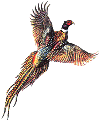
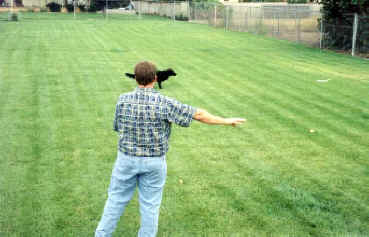 Throw the first bumper back to the same location 20 feet LEFT of the dog
(bumper A). Now cast the dog to the RIGHT bumper (B). At first, this will be a job since
the dog has forgotten all about the right bumper. Walk towards the right bumper casting
your arm and saying "OVER". If the dog turns toward the left bumper yell NO!
SIT! And praise him when he stops and sits (you can start working on that sit command now)
and then cast right with an "OVER, GOOD, OVER". When the dog picks up the bumper
give him lots of praise.
Throw the first bumper back to the same location 20 feet LEFT of the dog
(bumper A). Now cast the dog to the RIGHT bumper (B). At first, this will be a job since
the dog has forgotten all about the right bumper. Walk towards the right bumper casting
your arm and saying "OVER". If the dog turns toward the left bumper yell NO!
SIT! And praise him when he stops and sits (you can start working on that sit command now)
and then cast right with an "OVER, GOOD, OVER". When the dog picks up the bumper
give him lots of praise. 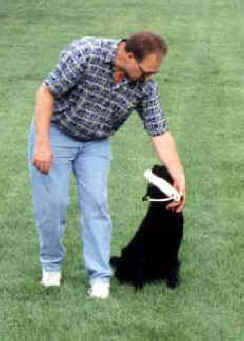
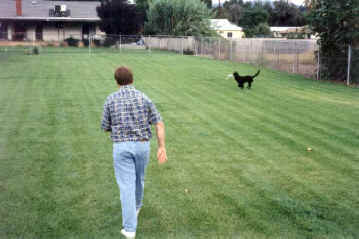
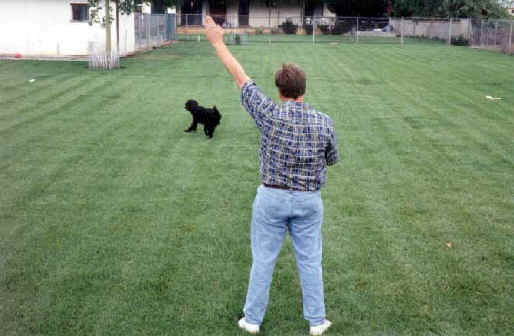
 Now, as you make one step right (body english), cast straight up with your
right arm and give a verbal "BACK" command. The body english is to get the dog
turning in the correct direction. Body english can be stopped when the dog consistently
turns the correct way. Watch Cupcake to make sure he turns towards the arm you cast with.
If Cupcake turns the wrong way yell "NO, NO, SIT" to stop him. As soon as the
dog looks at you step right and recast. Give the dog a "GOOD" when he turns the
correct way.
Now, as you make one step right (body english), cast straight up with your
right arm and give a verbal "BACK" command. The body english is to get the dog
turning in the correct direction. Body english can be stopped when the dog consistently
turns the correct way. Watch Cupcake to make sure he turns towards the arm you cast with.
If Cupcake turns the wrong way yell "NO, NO, SIT" to stop him. As soon as the
dog looks at you step right and recast. Give the dog a "GOOD" when he turns the
correct way.